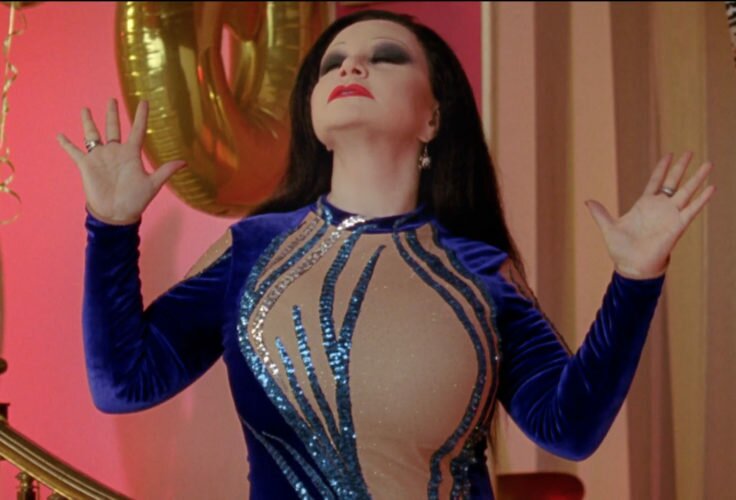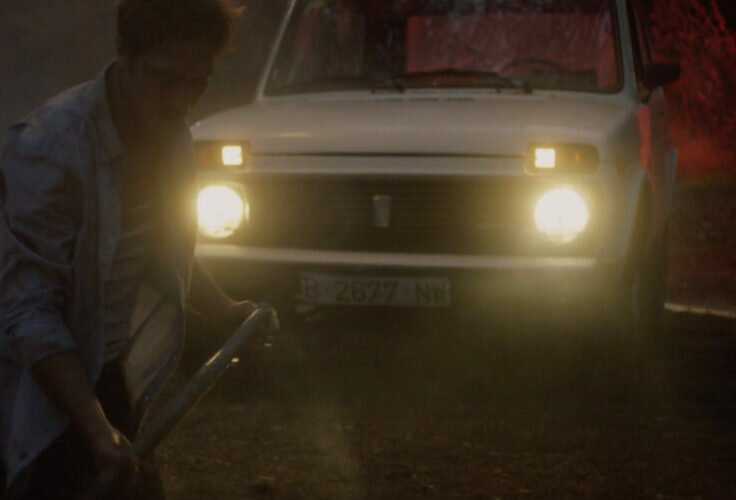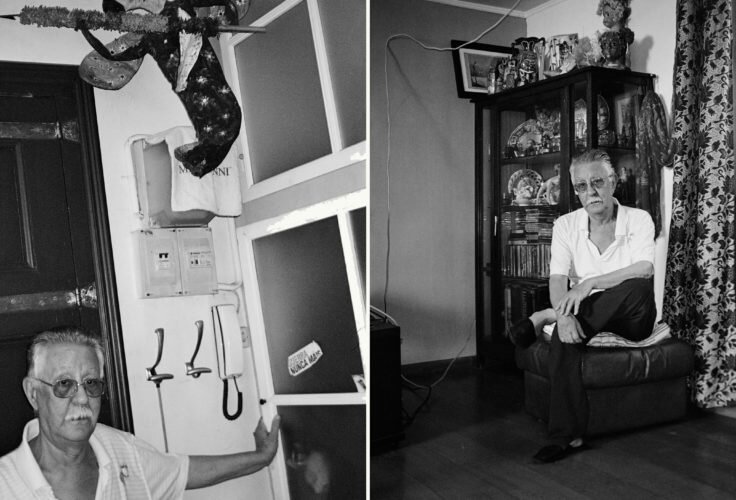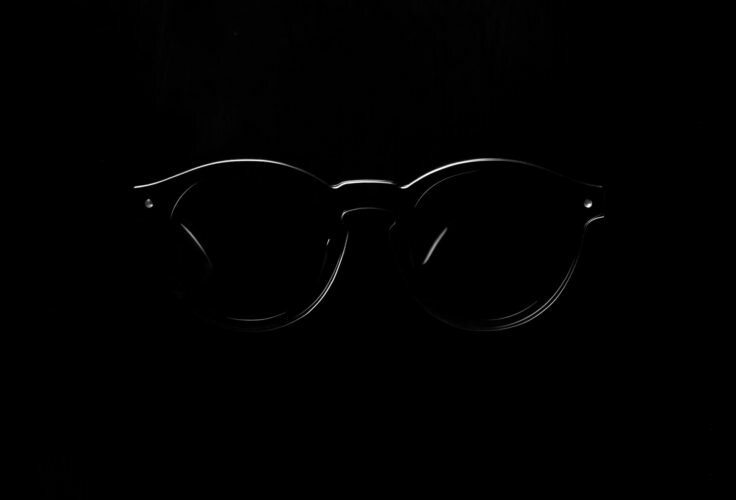Vaughan Oliver is the designer who changed the record cover paradigm. Joan Pons interviews the genius who devised the artwork for the Pixies and, in general, all the 4AD catalogue.
1. Not keeping up appearances
I guess there must be previous cases to this one, but be it due to the lack of audiovisual material, be it due to sheer ignorance, the first singer I read about who had become conscious of the expression of his movements was Jacques Brel. His detractors said that he was like a histrionic punch, all wild gesticulations and no subtleness. That performing style, moving his arms so exaggeratedly, had nothing to do with refinement (a critique years later one of his followers would receive: , of course). Brel’s answer was to directly increase this overacted manners: he let the cuff of his white shirt slip under the jacket so that the flourishes his hands draw in the air would stick out even more in front of the spotlight at the Olympia. That is to say: he voluntarily lost his human dimensions to become an anthropomorphic symbol; he renounced to keeping up appearances and gestural good taste in front of the bourgeois audiences that criticised him but whom, paradoxically, ended up dazzled by that puppet laughing at them in their own faces.


2. Listen to my hips
If bodily revolution at the chanson took place from the waist upwards, for rock it was, as we all know already, from the navel down. If foundational rock’n’roll lyrics could be read following softer/whiter interpretations, the new dances that accompanied them left no room for double entendre: this music is about fucking. Any audiovisual archivist knows that the first forced the change in camera angles when shooting musical shows: in his second appearances there was no more long shots, but it was all resolved with . The pelvis from which the musician’s nickname came from couldn’t be seen. Leaving the sexual swagger off-screen, what was left of the first Elvis was a diminished artistic expression, but still full of hormonal alteration. His image in motion dating from fifties shows (although his are also way cool) were a whirlwind of arousal: The kinetic Vitruvian man of rock.
3. Without movement, there’s no rock (nor maybe roll)
The common ground that attributes to pop a mild stage presence and to rock a rollicking good time has, like any clichés, something of truth, at least in its first instances. Like the one that said the Beatles were the good guys and the Rolling Stones, the baddies. You only need to watch Peter Whitehead’s documentary Charlie is my Darling, one of the first documentaries on Jagger, Richards and company. What happened under the spotlights during this Irish tour had a component of danger, seduction and madness that had nothing to do with other shows from the times. I mean: they weren’t exactly four logs playing in front of people. They wanted respectable audiences to stop being so: to follow and get carried away by their lower instincts and the main emotion they felt for their idols was desire, not platonic admiration. And it’s all Mick’s fault, since he was like a lizard’s tail. Although the soundest apotheosis (both as synonym of flashy and of hallucinatory) was Jagger’s singing Sympathy for the Devil in Rock’n’roll Circus; a hypnotising and fake satanic ritual in which the vocalist turns out of his head necromancer.
4. Beat this now, whitey!
Wait a minute! But what’s this nonsense? We’re only talking about whites! As if Chuck Berry’s (those steps that would so much inspire ), ‘s excess, intermittent contortions, ‘s kicks or supporting coordinated moves hadn’t existed at all. In fact, to continue the thread about the Stones and of the si non è vero, è ben trovato, we only need to watch the documentary The T.A.M.I. Show, which includes one of the first US festival shows performed by the British band. The apocryphal version says that James Brown didn’t like very much he wasn’t the last one to perform. So his show as the one-before-last on the festival was a magma of dance energy. And now you go out and perform, c’mon! Jagger says it wasn’t exactly like that and they didn’t jump onstage daunted and (almost) ashamed. But the unfair disadvantage, , gives reason to rumorology. Soul beat the shit out of rock. And James Brown was a machine (although Joe Tex says he stole many steps from him). THE machine. He even gave lessons on how to become one:
5. Leave me alone
Wait a minute (again)! But what’s this nonsense (again too)? We’re only talking about men! And, in the end, many of the great names that shook up the way to perform before a microphone were women. Until La Lupe appeared, for example, with legendary accidents such as the day she took her shoes off live onstage and hit the piano player with them, TV was a bore. In fact, she would often place herself in front of the cameras alone, without the warmth of the massive bands that accompanied Latin music at the time. No one could beat her when it came to knowing the power of her body expression. In this sense, she’s close to Lola Flores, the only person who managed to get Valerio Lazarov shooting her performances without almost . What for? The important and vibrant thing was in front of the shot, not in the shot. She even gets off-screen at times! Her power, and at times empowerment, was this. Comparing her with , repeated so many times that now it sounds like a wild cliché, is not so far-fetched.
6. It came out like that
In fact, we’re going round in circles about the same topic. All pioneers of bodily expression in popular music are now seen as creators of forms because back in the day they dared incorporating movements that were unexpected. Maybe they just knew no others (and didn’t want to know). It came out like that instinctively, just by letting themselves go. But if the sound was new, the way to match the body to that new sound should be new too. In this sense, as valuable are the innovations onstage that Jim Morrison brought from his peyote trips thinking himself , as ‘s jumps and bicycle moves or the two steps beyond, two steps back performed by , ‘s tell-tale mannerisms or ‘s mime tricks. Vampire suctions from other arts or scenic rituals that would become part of the idea of what a musical show (or a certain canon, even) could be because back then one of this visionaries thought that was the way it should be.
7. Chicken or the egg
There comes a time when a singer’s body expression, when he really abandons himself to it, ends up bringing up a wonderful doubt: is the performer moving to the rhythm of the sounds he generates or is music the one adapting to the musician’s swagger? A blurred barrier that in cases such as Iggy Pop’s can, at times and due to repetition, even border on the caricature. However, Iggy’s excessive numbers were in may ways a canon. Not so much for the direct copies of his onstage moves, but for the feeling that in his seventies performances, Jim Mewell was only an anthropomorphic carcass activated by an uncontrollable inner drive that reacted to what came from the speakers. More than in any other case, Iggy is the paradigm of dancing wrongly well; of the animalization of a human being that decides to become a singer; of proto-punk that affect more than just the musical sphere. These wild performances would inspire, in their most straightforward aspect, or , and in their hidden meaning, (even if in his music-hall mascarade there are also hunchback walks taken from Shakespearian characters) and the most daring , when she didn’t adorn her rhapsodies with absinthe poet mannerisms.
8. Take me or leave me
Another enthralling doubt, just for the pettiness of its resolution, would be to ask whether these performances are real or phoney. It doesn’t matter all that much, of course, We can play at, obviously, speculate whether Ian Curtis’ spasms were fruit of his inner torment (we later found out about) or was the orthopaedic way he came up with to individualise his proposal in front of the microphone. What goes a bit beyond mere speculation, quoting Picasso, welcome be any imitators, because their defects will be theirs (yes, I’m talking about you, ). The creation of choreographies or intuitive gestures always hits originality with great force. Even if, and above all, it’s of the “take it or leave it” kind. When a singer’s acting is exposed to ridicule is just when loves and hates appear. And then, this questioning of whether it’s fake or not is unnecessary: it’s just questioning. It places you as spectator (more than as listener) on the ropes. Do you buy that Kate Bush or a pre-Raphaelite pantomime (her studies of theatrical acts taken to an overacting extreme)? Or that Siouxsie thinks she’s the reincarnation of a Klimt painting? Are you repelled by the fact David Byrne thinks his body is made of rubber (another case of singer interested in contemporary dance)? Would you prefer The Smiths’ songs without all ? Which one was better, the Michael Stipe that behaved as an or the one who turned into an ? Could Madonna have spared all those hand moves shown in ? Do you think was just the Happy Mondays’ pet and they would be better off without him? Well, you should now that it’s exactly there, in shock and weirdness, where the true differential factor resides; and the genius; and the hypnotic element; and the peculiarity that separates the average musician to the star, probably of the artist as well. Singularity can provoke rejection, obviously. But it can also change the whole general perception of a musical genre. Boys don’t dance (, as Allo Darlin’ said)? Hardcore isn’t sexy? Ask Guy Picciotto:






9. Look, mum!
Again, I should be ashamed of myself. Again, I haven’t been mentioning black artists for paragraphs. As if with that precious one I had wrapped up the subject. And no, of course not! If James Brown’s heirs catch me they’ll kick my balls! I’m talking about the beneficiaries of his dancing mastery and lessons of stage attitude, not to the hyenas that fought over his last will and testament. I’m thinking about Prince, for instance, whom, as legend says, the Godfather was watching at a show from the VIP seta with Michael Jackson, to whom he said, sotto voce: “Learn”. But no matter what JB said, I’m also thinking about Jacko, of course. Maybe James Brown wasn’t his only reference (here and also here you can track down his diverse sources of inspiration) and he wasn’t a dancer purely following his instinct, there was a lot of behind it with choreographers and professional dancers behind it all. Otherwise he wouldn’t have been able to turn each and every one of his moves into attention seeking baits. Mum, mu, look what I can do! The apotheosis being his number to present Billie Jean at Motown’s 25th anniversary gala: thus, the icon was born. The show you can watch up here (or down here, I never know where designers are going to place stuff, always following their good composition criteria), was commented by Martin Scorsese back in the day: “Every step he took was absolutely precise and fluid at the same time. It’s like watching quicksilver in motion”. And Gerard Casau, more recently and in private, added: “out of each step and movement you could do a GIF”:



10. The isolated gesture
At tumblr account they’ve precisely devoted some post to extracting GIFs from singers’ particularly iconic gestures. And it’s very obvious. From the music video, for example, they atomise Nick Cave’s gesture (always looking like a preacher; ‘s revival show always present), Blixa Bargeld’s accidental dancer charisma and Jarvis Cocker’s dandyism. All they, Jarvis probably the most (at Pulp he always kept the spotlight to himself, both onstage and on ), have a very referential and self-conscious bodily expression. They don’t belong, obviously, to the genesis, or classicism, or splendour days of, let’s say, bodily music. They’re just adding to the tradition. In the same way that, as Martin Rev reflected upon Suicide, pop and rock entered in the nineties into its era of re-interpretation, leaving behind the creation era (as happened before with jazz), its physical and visual manifestation is also, from a moment on, only a question of performing, and not creating, excellence. Not too genuine? Over-studied? Maybe. But we have to celebrate the fact the three of them decided to be extravagant knowing that their audience would precisely stay (and even fall in love with them) thanks to one of their unorthodox tics seen onstage.
11. Captatio benevolentiae
I reach the end of this text with a guilty conscience. I’m not trying to be encyclopaedic, but I wouldn’t like to finish an article written in 2016 with twenty-year old references. So I’ve decided to look at the present (or near past) and I fancy highlighting some artists’ whose body movements are very musical indeed. I could start by and her update on the Tina Turner myth (so sui generis and powerful that it becomes, because of that, easy to caricature, as Maya Rudolph knew quite well at SNL). Or positively valuing Thom Yorke for not being scared of ridicule or of becoming a strain of memes in the music video. Or defending the feline madness of Tomasito, the one that inspired the Tigrinho in Pedro Almodóvar’s La piel que habito. Or maybe celebrating ‘s repertoire of poses, mannequin-come-to-life style (or like a disciple). Although I’ve got to say that the current artists that has realised the most the fascinating and magnetic power of his body in movement is, without a doubt, Stromae. In fact, in each new audiovisual project he launches it becomes clear he knows very well that his body is part of his creative proposal. And there we have to include both his sapeur-in-schooling-phase clothes as his mere die-cut silhouette over a clear background in the Quand c’est music video or the concert Racine Carrée Live, which directly starts with a praise of the shadows of videogame Limbo. I don’t know whether he’s our present day Jacques Brel or not (if he was, this text would become full circle!), but I’m sure he’s the last singer that, apart from being unable to stop listening to, we just can’t stop looking at.



















